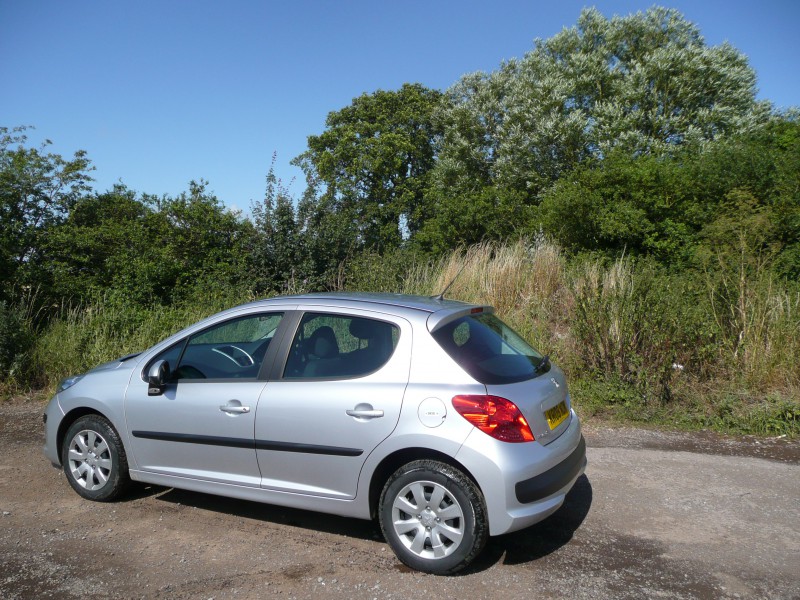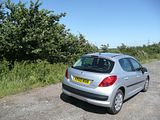

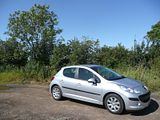
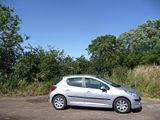
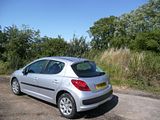
 During the ’80s and ’90s, Peugeot built up a formidable reputation. A marque once renowned for sober delivery of a “solid” range of cars for the French Bourgeoisie was transformed into a volume seller, whose cars were known for lively performance and especially for their handling prowess, which made them fun to drive. The fact that the cars were styled with the assistance of Pininfarina meant that they all looked good. Only the rather patchy build quality caused some concerns. And then, it all went wrong. Peugeot decided to style their cars in house, and common consensus is that each successive car from the 206 onwards has been even more gawky than the last, with just the exception, such as the 407 Coupe. The class-leading steering and handling seemed to be consigned to the history books, too, with particular disappointment being expressed at every GTi model. The sole improvement seemed to be build quality, though early purchasers of the 307 would probably dispute even that. Somewhat perversely, sales soared. The 206, a supermini that was never better than class average, frequently achieved the distinction of being the best-selling car in the non-fleet market in the UK, and millions of them were made. Two years ago, a replacement appeared, called the 207. Slightly larger than the outgoing car, and with very derivative styling – certainly not an improvement, but less of a disaster than the 307 to 308 change – it received a luke-warm response from the motoring press, and yet has continued to sell in huge quantity. Time to find out for myself whether the press are correct, or the buying public.
During the ’80s and ’90s, Peugeot built up a formidable reputation. A marque once renowned for sober delivery of a “solid” range of cars for the French Bourgeoisie was transformed into a volume seller, whose cars were known for lively performance and especially for their handling prowess, which made them fun to drive. The fact that the cars were styled with the assistance of Pininfarina meant that they all looked good. Only the rather patchy build quality caused some concerns. And then, it all went wrong. Peugeot decided to style their cars in house, and common consensus is that each successive car from the 206 onwards has been even more gawky than the last, with just the exception, such as the 407 Coupe. The class-leading steering and handling seemed to be consigned to the history books, too, with particular disappointment being expressed at every GTi model. The sole improvement seemed to be build quality, though early purchasers of the 307 would probably dispute even that. Somewhat perversely, sales soared. The 206, a supermini that was never better than class average, frequently achieved the distinction of being the best-selling car in the non-fleet market in the UK, and millions of them were made. Two years ago, a replacement appeared, called the 207. Slightly larger than the outgoing car, and with very derivative styling – certainly not an improvement, but less of a disaster than the 307 to 308 change – it received a luke-warm response from the motoring press, and yet has continued to sell in huge quantity. Time to find out for myself whether the press are correct, or the buying public.
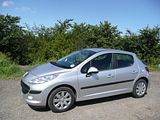
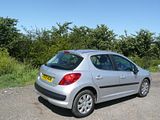
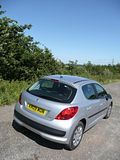 The test car is one of the best-selling models from a large range. A 5 door hatchback in “S” trim, and fitted with Peugeot’s 1.6 litre HDi diesel engine, in 90 bhp format. As Peugeot’s entry in the fiercely competitive supermini class, the 207 has no surprises at all. It’s the same size, has the same power, costs the same and has the same sort of equipment levels as you could expect to find in each of its mainstream rivals. And there are lots of them: Fiesta, Clio, Grande Punto, Yaris, Jazz, C3, Polo, Colt, Ibiza, Fabia…… the list is long. Two years have helped to acclimatise me to the styling, though I do still prefer the 206. The huge headlights that go back most of the way to the windscreen might be OK, but that awful gaping grille, like a mouth stoppered up with a huge black lump of plastic is just unfortunate. The door mirrors that look like they have dropped about a foot from where you would expect them to be anchored to the car don’t help (and their shape means that although they are huge, they do not give the panoramic view behind you that you might expect). With the exception of the grille, it’s not unbearably ugly, but it’s a long way from being an attractive car.
The test car is one of the best-selling models from a large range. A 5 door hatchback in “S” trim, and fitted with Peugeot’s 1.6 litre HDi diesel engine, in 90 bhp format. As Peugeot’s entry in the fiercely competitive supermini class, the 207 has no surprises at all. It’s the same size, has the same power, costs the same and has the same sort of equipment levels as you could expect to find in each of its mainstream rivals. And there are lots of them: Fiesta, Clio, Grande Punto, Yaris, Jazz, C3, Polo, Colt, Ibiza, Fabia…… the list is long. Two years have helped to acclimatise me to the styling, though I do still prefer the 206. The huge headlights that go back most of the way to the windscreen might be OK, but that awful gaping grille, like a mouth stoppered up with a huge black lump of plastic is just unfortunate. The door mirrors that look like they have dropped about a foot from where you would expect them to be anchored to the car don’t help (and their shape means that although they are huge, they do not give the panoramic view behind you that you might expect). With the exception of the grille, it’s not unbearably ugly, but it’s a long way from being an attractive car.
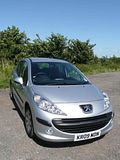

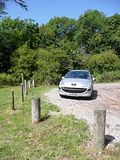
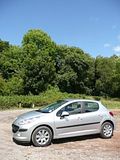 Not long ago, 90bhp in a small car would have endowed it with hot (well, warm) hatch type performance. Not so in the 207, which is an indication of how cars have got larger and heavier. The engine is refined, and it revs happily enough all the way to the red line at 4750 rpm, but you would never describe it as any better than adequate. You have to work the car hard, and if you do so, it has no issues in keeping up with the traffic. I don’t think I want the same engine with 20 bhp less, which Peugeot do also offer. Getting the best out of the engine is not easy, though, as this forces you to use the gears. The gearchange of the 207 has to rank among one of the worst around. There’s no reluctance in engaging a gear – well, with the possible exception of being sure you have got reverse – but the change is vague, and sloppy, and utterly unpleasant to use. When the lever is in a given gear, the amount of slop is just incredible. You could move the long wand of a lever about 2″ in any direction, without if having any impact on the selected gear. Once you have reached motorway cruising speed, the engine is reasonably quiet, and the rather notable tyre roar on several of the different road surfaces which I encountered dominates. At start up and idle, this is obviously a diesel, but after that, it is actually pretty muted, and it is the reasonable swell of torque that reminds you that are driving derv powered. The 207 wins few points for any of its other driving dynamics. The steering is light, but pretty feel-less. Handling could best be described as neutral. There’s nothing wrong with it, as the 207 hangs on in exactly the way you would expect as you go round the bends, and there is a certain amount of body roll while you do so. The brakes did not impress, either, as they seemed somewhat grabby and were difficult to modulate smoothly. There is a traditional central pull-up handbrake, but this has an enormous button on the end, which makes it a tad more awkward to use than most brakes of its type.
Not long ago, 90bhp in a small car would have endowed it with hot (well, warm) hatch type performance. Not so in the 207, which is an indication of how cars have got larger and heavier. The engine is refined, and it revs happily enough all the way to the red line at 4750 rpm, but you would never describe it as any better than adequate. You have to work the car hard, and if you do so, it has no issues in keeping up with the traffic. I don’t think I want the same engine with 20 bhp less, which Peugeot do also offer. Getting the best out of the engine is not easy, though, as this forces you to use the gears. The gearchange of the 207 has to rank among one of the worst around. There’s no reluctance in engaging a gear – well, with the possible exception of being sure you have got reverse – but the change is vague, and sloppy, and utterly unpleasant to use. When the lever is in a given gear, the amount of slop is just incredible. You could move the long wand of a lever about 2″ in any direction, without if having any impact on the selected gear. Once you have reached motorway cruising speed, the engine is reasonably quiet, and the rather notable tyre roar on several of the different road surfaces which I encountered dominates. At start up and idle, this is obviously a diesel, but after that, it is actually pretty muted, and it is the reasonable swell of torque that reminds you that are driving derv powered. The 207 wins few points for any of its other driving dynamics. The steering is light, but pretty feel-less. Handling could best be described as neutral. There’s nothing wrong with it, as the 207 hangs on in exactly the way you would expect as you go round the bends, and there is a certain amount of body roll while you do so. The brakes did not impress, either, as they seemed somewhat grabby and were difficult to modulate smoothly. There is a traditional central pull-up handbrake, but this has an enormous button on the end, which makes it a tad more awkward to use than most brakes of its type.
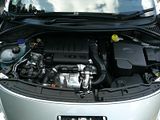
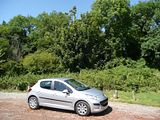
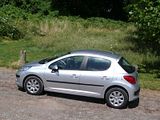

 There is no doubting the improved quality of the interior trim. Those good-to-drive ’90s Peugeots used to be badly made when new and looked very tatty very quickly. The 207 is finished with a perfectly acceptable quality of plastics, which fit well, and look like they would last far better. I was disappointed to find that there was an intermittent rattle in the door trim of the driver’s door of the test car, even though it had only done 585 miles when I collected it. However, I quickly found something far more disappointing. In an effort to provide a little visual variety of the dark coloured dash, there is an aluminium effect trim around the centre of the dash moulding which surrounds the information display and central air vents. This trim reflects badly in the front screen and was particularly annoying. The same trim also surrounds the air vents at the end of the dash, but as these are less horizontal, they do not manifest the same problem. The dash comprises a main hooded binnacle, which houses the 2 larger instruments and smaller gauges, an info display, recessed at the top of the centre of the dash, above the stereo and air con controls. The instruments have a lot of calibration markings in them, and seemed a bit fussy. The stereo, a relatively basic unit, has very small buttons on it which proved very fiddly to use. Column stalks from the PSA parts bin appear, and these control lights, wipers and indicators, and they seemed to be of decent quality. Thankfully, and unlike the 206, the wipers have been converted for right hand drive, so they sweep the upper right part of the screen properly.
There is no doubting the improved quality of the interior trim. Those good-to-drive ’90s Peugeots used to be badly made when new and looked very tatty very quickly. The 207 is finished with a perfectly acceptable quality of plastics, which fit well, and look like they would last far better. I was disappointed to find that there was an intermittent rattle in the door trim of the driver’s door of the test car, even though it had only done 585 miles when I collected it. However, I quickly found something far more disappointing. In an effort to provide a little visual variety of the dark coloured dash, there is an aluminium effect trim around the centre of the dash moulding which surrounds the information display and central air vents. This trim reflects badly in the front screen and was particularly annoying. The same trim also surrounds the air vents at the end of the dash, but as these are less horizontal, they do not manifest the same problem. The dash comprises a main hooded binnacle, which houses the 2 larger instruments and smaller gauges, an info display, recessed at the top of the centre of the dash, above the stereo and air con controls. The instruments have a lot of calibration markings in them, and seemed a bit fussy. The stereo, a relatively basic unit, has very small buttons on it which proved very fiddly to use. Column stalks from the PSA parts bin appear, and these control lights, wipers and indicators, and they seemed to be of decent quality. Thankfully, and unlike the 206, the wipers have been converted for right hand drive, so they sweep the upper right part of the screen properly.
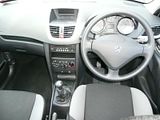
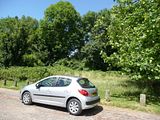
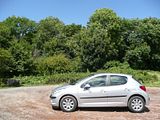 The 206 was criticised for its driving position, though I never had a problem with the 2 (admittedly left hand drive) examples I drove. I did have issues with the 207, though. Not only did it not seem to be possible to get the relative position of seat, pedals and steering wheel to be where I wanted it, but I found that resting my left foot on the flattened area (a sort of virtual foot rest), meant that my left leg was embedded in the centre console. The seat backrest adjusts in a series of steps with a very awkward lever which is all but impossible to reach through the seat belt, attached at the base of the seat, and was awkward to use. Whereas the seat itself was comfortable enough, I thought the seat trim – a sort of coarse-grained gauze – was particularly horrid, too. Mind you, most volume sellers these days have truly unpleasant seat covering. The steering wheel is just plain ugly, too. It looks as if there is too much air bag stuffed into it, and so the outer covering is convex. A huge lump of black plastic with just a small lion badge in the centre does not help to create the best visual impression.
The 206 was criticised for its driving position, though I never had a problem with the 2 (admittedly left hand drive) examples I drove. I did have issues with the 207, though. Not only did it not seem to be possible to get the relative position of seat, pedals and steering wheel to be where I wanted it, but I found that resting my left foot on the flattened area (a sort of virtual foot rest), meant that my left leg was embedded in the centre console. The seat backrest adjusts in a series of steps with a very awkward lever which is all but impossible to reach through the seat belt, attached at the base of the seat, and was awkward to use. Whereas the seat itself was comfortable enough, I thought the seat trim – a sort of coarse-grained gauze – was particularly horrid, too. Mind you, most volume sellers these days have truly unpleasant seat covering. The steering wheel is just plain ugly, too. It looks as if there is too much air bag stuffed into it, and so the outer covering is convex. A huge lump of black plastic with just a small lion badge in the centre does not help to create the best visual impression.
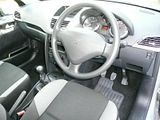
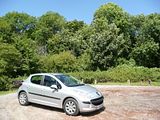
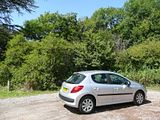
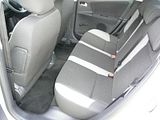 Accommodation inside the 207 is about what you would expect and comparable with all its rivals. These cars are now far bigger than the 205s and Unos of the 1980s, and they have not gained as much space inside as they have gained in exterior dimensions. Nonetheless, a family with 2 small children could fit in this car, and even take a reasonable amount of luggage with them. The glove box, it has to be said, looks like it should be huge, but when you open it, it is quite a surprise to find that there is just a small cube shaped area to the right side of the large area covered by the lid. There is a lipped area above the lid, and two quite commodious door pockets, as well as a couple of small places in the centre console for odds and ends. Rear seat space is adequate for 2 and 3 could be squeezed in for shorter journeys. The boot is class competitive, though the area behind the wheel arches has been squared off, so while you do get a regular shape, it is not that wide. Under the floor, there is a moulding to hold the tools for the “get you home” foam, and that’s it. The rear seat cushions lift up, though the parallelogram-style hinge felt flimsy and I feared I had broken it, and then the backrest drops into the space, leaving a larger luggage area that slopes upwards slightly.
Accommodation inside the 207 is about what you would expect and comparable with all its rivals. These cars are now far bigger than the 205s and Unos of the 1980s, and they have not gained as much space inside as they have gained in exterior dimensions. Nonetheless, a family with 2 small children could fit in this car, and even take a reasonable amount of luggage with them. The glove box, it has to be said, looks like it should be huge, but when you open it, it is quite a surprise to find that there is just a small cube shaped area to the right side of the large area covered by the lid. There is a lipped area above the lid, and two quite commodious door pockets, as well as a couple of small places in the centre console for odds and ends. Rear seat space is adequate for 2 and 3 could be squeezed in for shorter journeys. The boot is class competitive, though the area behind the wheel arches has been squared off, so while you do get a regular shape, it is not that wide. Under the floor, there is a moulding to hold the tools for the “get you home” foam, and that’s it. The rear seat cushions lift up, though the parallelogram-style hinge felt flimsy and I feared I had broken it, and then the backrest drops into the space, leaving a larger luggage area that slopes upwards slightly.
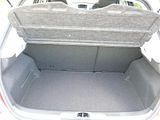
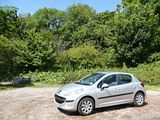
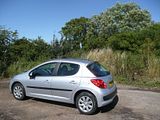
With the exception of the gearchange, which was just bad, there is nothing that the 207 does which is really poor. But there is also nothing at which it excels. This is a highly competitive class, with some truly excellent cars (Fiesta and Polo), and some others which have real appeal for other reasons, the Grande Punto, for its styling and its diesel engines, for instance), so I really could not work out why anyone would buy a 207. It seemed to be no better than average at anything. It’s unlikely to sell on its style. It’s not even particularly cheap. Whilst the French may select it as a show of pure national loyalty, I think you could do better almost anywhere else. Very disappointing indeed.
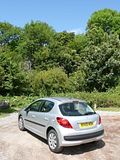
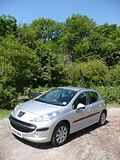

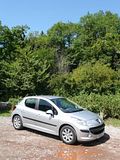
2009-07-13 15:43:46

